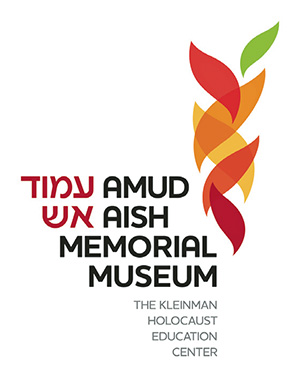


Brooklyn—The Kleinman Holocaust Education Center (KHEC) is expanding and rebranding as The Amud Aish Memorial Museum. The museum and education center bring a new voice to the study of Holocaust history. Through the inclusion of the experience and perspective of observant communities, the museum and education center bear witness to the world of observant Jews and how they lived before, during and immediately after the Holocaust.
Amud Aish is the first museum of its kind. Current Holocaust museums have generally focused on the story of the perpetrator in understanding why the Holocaust happened and how to ensure it never happens again. The Amud Aish Memorial Museum will focus on telling the victims’ stories with a focus on what was central to many of them: maintaining their faith and observance in times of extraordinary adversity. The museum will open in Brooklyn in 2017. The collections and educational programs have been hosted in a temporary space in South Brooklyn since 2009.
“In the 71 years since the end of the Holocaust, no museum has represented the experiences of the religiously observant communities. Observant individuals suffered so much and yet managed to maintain their faith in the most incredible ways,” said Rabbi Sholom Friedmann, Director of The Amud Aish Memorial Museum and KHEC. “This museum will, for the first time, tell their stories and fill in a huge missing part of Holocaust history.”
The Amud Aish Memorial Museum was first founded as the KHEC in 2009 primarily to educate the public, educators and scholars on the religious perspective of the Holocaust, along with a smaller exhibit component.
“As soon as we began going into the community with educational programs, we were approached by survivors and their families about donating Holocaust-related documents and artifacts. These are items that members of the observant community were previously unwilling to donate to Holocaust museums. We also heard from observant families who were based in the United States as well as around the world, who spent the war fighting to save loved ones and strangers alike trapped in Europe. Today the archive has many hundreds of thousands of artifacts and documents,” said Rabbi Friedmann.
In addition to the tremendous growth of the archives, the organization hosts public historical lectures, annual Tisha B’Av (national day of mourning) exhibitions, school group visits, educational programs at summer camps and international exhibitions. As the mission, vision and work expanded, the organization could no longer be described only as an “education center.” In an effort to reflect its expanded role, the KHEC sought input from the community and worked to create the new identity: The Amud Aish Memorial Museum.
The term “amud aish” means “pillar of fire” and it is a biblical reference: In the book of Exodus, when the Jews were wandering the desert at night, a pillar of fire illuminated their way. The Jewish people look to their history for guidance on how to address their own communal and personal challenges, and how to move on from difficult times. Like the amud aish, the lessons of the Holocaust are a guiding light for today’s Jews—and an inspiration to all people—on how to keep faith and maintain hope even in the darkest hours.
The Amud Aish Memorial Museum logo represents the pillar of fire, which begins with a deep red flame signifying the darkest period in Jewish history. As the years since the Holocaust ensue, the flames of destruction become less burdened, evolving ultimately into a leaf of renewal, symbolizing the remarkable resurgence of Jewish life. The pillar culminates in a bright green leaf, expressing the assurance of the future of the Jewish people. It is optimistic as it stands tall and is propelled upward, representing true growth that can come only through education. The leaf attempts to break free from the pattern of destruction by teaching all people how to learn from the past and to apply those lessons to the future. This is the core objective of The Amud Aish Memorial Museum.
In addition to the permanent and temporary exhibits in the museum, Amud Aish and KHEC have four key divisions: the Orthodox Testimony Project (in conjunction with the United States Holocaust Memorial Museum), the Document & Research Archive, the Artifact Collections Archive and the International Division.










